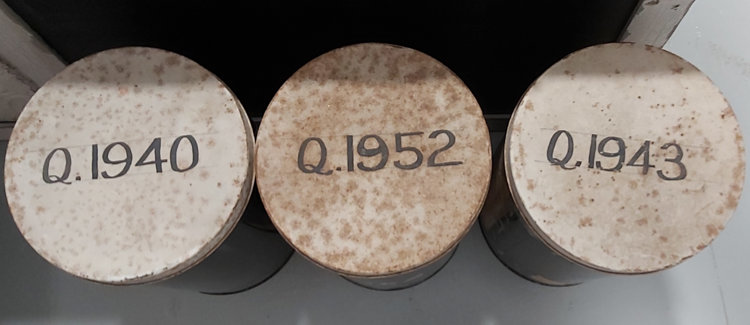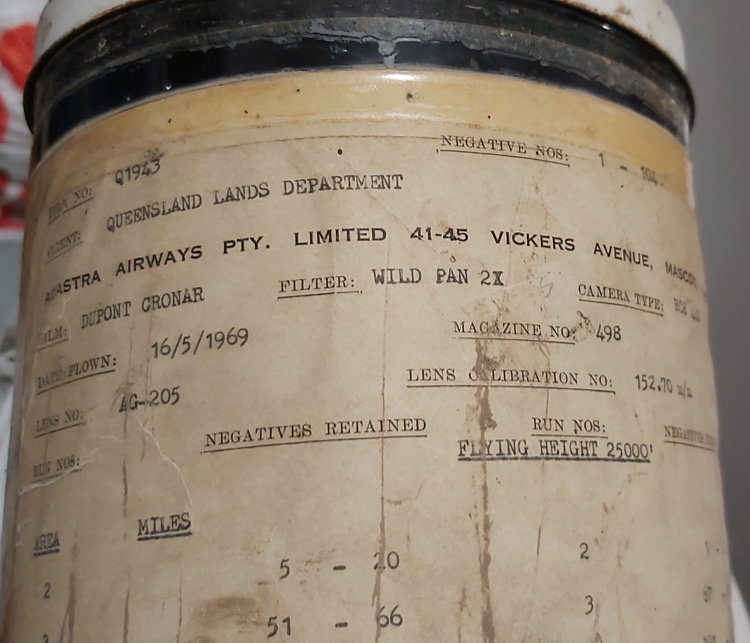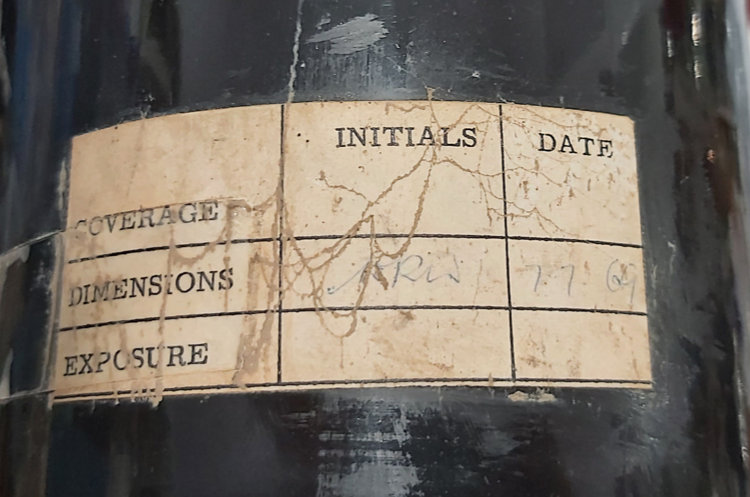|
The things one finds
in antique shops! Debra Ray-Thompson found these Adastra film canisters
and sent these images.
As per the labels, they once contained nine inch wide Dupont Cronar
black and white negative film which Adastra used in a Wild RC8 camera
on a Queensland Lands Department contract in the Dulacca area flown
at 25,000 feet on 16 May 1969. The aircraft is unknown but it was
probably one of the Hudsons.
Doug Morrison recalls:
The
film is cronar/mylar and that would be right for the era – maybe
that was one of the reasons the film could have been destroyed
as these early mylar based films (like some of the animal product
based drafting films) eventually gave off extremely potent/obnoxious
smell as it deteriorated with age. I have been unable to get
access to certain old photos/films in overseas libraries because
the material has been sealed and quarantined due to the ‘toxic’
odour. I can remember using mylar based 35mm film for survey
tracking cameras in the late 1960s but we stopped using such
film because it wouldn’t tear – in fact I saw a camera spool
mechanism in a tracking camera completely destroyed by some
film that came off its notches and just continued to wrap and
jam until the mechanism was torn off its bearings and seized
the drive motor. I don’t know if anyone had such issues with
the big photo cameras with mylar based films but a jam in one
of those cameras would be a very expensive occurrence. It was
certainly a popular film in that era though and you can be almost
certain that Kevin Pavlich had an involvement in supplying that
film to Adastra as he worked for 3M selling such stuff along
with 3M's Cronaflex drafting translucent mylar – the preferred
topographic mapping material - very stable (no expansion or
contraction). Kevin sold such to us when I was with GRD Co.
The mylar film could be coated with photographic chemicals and
used as negatives/auto-positives for large format lithographic
cameras (like Adastra had). Before the mylar based drafting
film there was very little stable based material around and
this had been a real issue since maps were first made. Stable
based material was essential for producing printed maps where
multi-layered content existed (e.g., separate layers of drainage,
contours, planimetry, culture - i.e., roads fences buildings
etc). Before the mylar based stable material there were stable
animal based drafting films – one being a product called ‘Astrafoil’
and I know Adastra used it as I can remember Brian Lenon telling
me about the time in the drafting office at Adastra one of the
draftsmen picked up his drafted map after many hours work on
it (40-80 hours of work) and as he moved from his desk he bumped
the edge of the map on a filing cabinet and the whole map shattered
into a thousand pieces. The mylar based materials were a godsend
for mapping. Stable, nice drawing surface, accepted most inks
(not all – inks needed to dry quickly), could be worked on both
sides of material and they didn’t shatter. |
Dulacca is quiet rural
town on the Warrego Highway, 43 kilometres west of Miles, Queensland.
First came the railway (in 1879) and then came the town; originally
spelt 'Doolackah', the name was derived from an Aboriginal name
meaning 'emu tracks'. An interesting point to note about Dulacca
is that it was the site of the first efforts to eradicate the invasive
prickly pear cactus. The fight to eradicate the prickly pear was
spurred on by the Government's reward of 40000 hectares of land
to whoever could restore their land to its original state. It is
estimated that the menacing plant covered more than 50 million acres
of Queensland at its peak. The town's hotel, known as the Waterhole
on the Hill, dates back to 1908.
(Source: https://www.queensland.com/au/en/places-to-see/destination-information/p-56b25e3b7b935fbe730dd118-dulacca)
|




